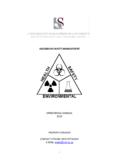Transcription of FY15 IC Payroll Chapter 4 Effective IC over Payroll
1 4 1 chapter 4 Effective INTERNAL CONTROLS OVER Payroll INTRODUCTION AND LEARNING OBJECTIVES Every organization, including governments, require employees to assist in meeting their goals and objectives. The cost of employing these individuals are reflected in salaries and wages and the associated benefits. The principal purpose of any Payroll department is to pay the employees and remit associated deductions, taxes, and benefits. Internal controls are necessary for this department to function effectively, efficiently and within the parameters set by management. After completing this Chapter , you should be able to Explain the Payroll process Recognize the objectives for Payroll Link the Payroll objectives to the five interrelated components of an Effective internal control system DEFINING THE Payroll PROCESS One of the largest expenditures for most governments is the payment of employees for providing services.
2 The cost of paying employees includes not only the employees gross pay. It also includes the employer s share of benefits. Often benefit costs make up nearly 40% of an employee s gross pay. The following is an example. The City of Vinson has an annual budget of $10,000,000. The budget can be summarized as follows Personnel $8,000,000 Operating $2,000,000 In this example, 80% of the budget is related to the Payroll process. Strong internal controls are necessary to ensure financial data is accurate. Many governments have a division of the accounting department dedicated to paying employees, called the Payroll Department. The size of the government determines whether the department is responsible solely for Payroll or if Payroll is just one of many responsibilities.
3 The Payroll Department is charged with paying employees accurately in accordance with policies and procedures established by the jurisdiction. A sample Payroll cycle is exhibited below. 4 2 Governments may perform all of these steps, or may contract out a portion of the process to a third party processor. Regardless of the method used, the resulting amounts will be posted to the general ledger. OBJECTIVES FOR Payroll As we learned in Chapter 1, Internal Control Review, objectives are a prerequisite to the establishment of an Effective internal control system. Those objectives are in three areas: Receipt of Time Sheets/Leave Taken Entry of Time into Payroll System Adjustments to Salary/Hourly Rates Enter changes to deductions and withholdingsBalance Hours, Salaries, Deductions, Withholdings, and Benefits Generate Paychecks/Direct Deposit Transmission File Deliver Paychecks to Employees, Transmit Direct Deposit, Remit Payroll Withholdings, Deductions, and BenefitsReconcile General Ledger Accounts Reconcile Bank Statement 4 3 Operations Reporting Compliance Listed below are three basic objectives of an internal control system: Objective 1.
4 To control operations by establishing various levels of authority, to provide approval for transactions and an adequate reporting system, and to enable those carrying out the approvals to be advised of the results from those approvals. Objective 2. To safeguard the organization s assets from loss or damage as a result of waste, inefficiency, error, theft or fraud. Objective 3. To provide adequate information that is timely and reliable and supports the control structures so that individual management responsibilities can be identified. To achieve these basic objectives, there are seven supplementary objectives that are also required to meet: 1. To ensure that all transactions are recorded. All valid transactions should be accurately recorded in the appropriate records, and valid transactions not recorded should be able to be detected by appropriate controls.
5 2. To record only valid transactions, and detect and protect against invalid transactions being entered. 3. To authorize only valid transactions and protect all records from unauthorized transactions. 4. To value transactions correctly and protect records from incorrect calculations and errors of recording. 5. To classify entries correctly in accordance with the chart of accounts or other categorizing requirements. 6. To record transactions in a timely manner so as to minimize errors caused by a delay between the transaction and its recording. 7. To include all transactions in the relevant subsidiary ledgers and correctly post them to the relevant ledger 1 Alan Trenerry, Principles of Internal Control (Sydney: UNSW Press, 1999) 9 10.
6 4 4 Applying the above objectives of an internal control system, the objectives for Payroll are as follows: All Payroll transactions are preapproved. All valid Payroll transactions are included in the accounting records in the proper period. All valid transactions are accurate, consistent with the originating transaction data, and information is recorded in a timely manner. All recorded Payroll transactions fairly represent the economic events that actually occurred, are lawful in nature, and have been executed in accordance with management s general authorization. Access to Payroll records are controlled and properly restricted to authorized personnel. Duties are assigned to individuals in a manner that ensures that no one individual can control both the recording function and the procedures relative to processing a transaction.
7 AN Effective INTERNAL CONTROL SYSTEM FOR Payroll As we discussed in Chapter 1, Internal Control Review, an Effective internal control structure has five interrelated components: Control environment Risk assessment Control activities Information and communication Monitoring Each of these components is important in establishing and maintaining an Effective control system for Payroll . THE CONTROL ENVIRONMENT AND Payroll Controls can either be an entity control or an application control. The control environment is considered to be an entity control because it addresses characteristics from management s Figure 3-1: Internal Control Components (COSO) 4 5 perspective rather than from an application such as Payroll software.
8 If the overall tone from management is not ethical and positive, then the possibility of the success of other internal control components is minimized. The control environment is the foundation on which all other internal control components are built. Just as the foundation of a house ultimately supports the entire structure, so does the control environment support the internal control structure of an organization. Let s review the principles of the control environment. These include: Demonstrates commitment to and ethical values Exercises oversight responsibility Establishes structure, authority, and responsibility Demonstrates commitment to competence Enforces accountability The control environment affects Payroll by establishing protocols.
9 A published code of ethics needs to be communicated with employees on a consistent basis. For example, employees should be required to read the code of ethics on entering the government s workforce and reminded of that code of ethics at set intervals during employment. Also, management needs to visibly adhere to that code. The code of ethics could also be published on the government s website. Personnel should be hired that have the knowledge and skills to accomplish Payroll tasks. This characteristic can be accomplished by including appropriate knowledge and skills in the job description so that only qualified employees are hired. In addition, employees should be supervised by qualified personnel.
10 The organizational structure of the Payroll department should be such that there are job descriptions that provide for assignment of responsibility and authority. These job descriptions should allow for proper segregation of duties. Written procedures should be provided in the Payroll area. These procedures should cover all phases of Payroll from when an employee is hired through the employee s separation from the government. Procedures should also address when an outstanding payment becomes legally an escheat property and submitted to the appropriate state agency. Management should exhibit a commitment to ongoing education and training process for employees in the Payroll area. This is especially important due to frequent updates to deductions and withholdings from employees pay.




